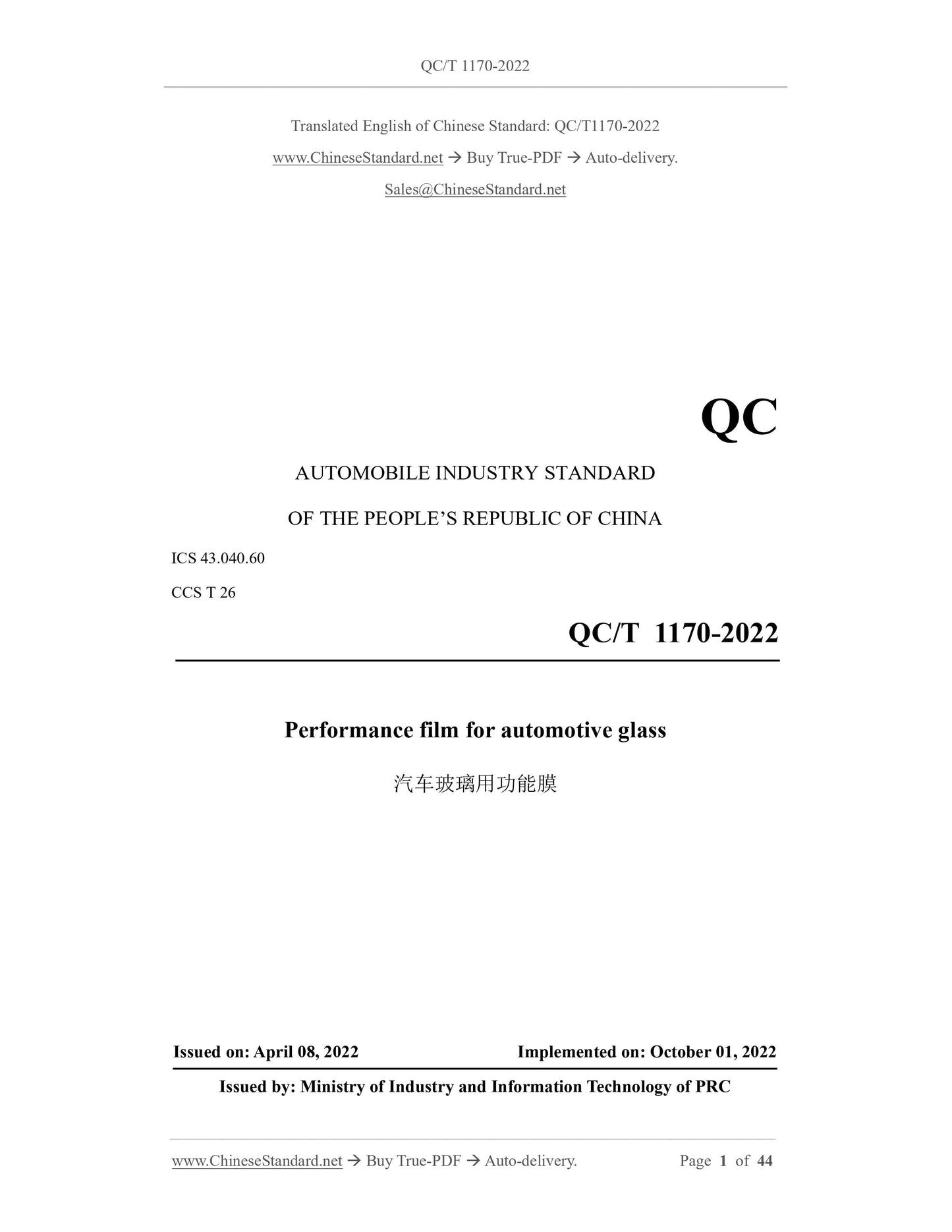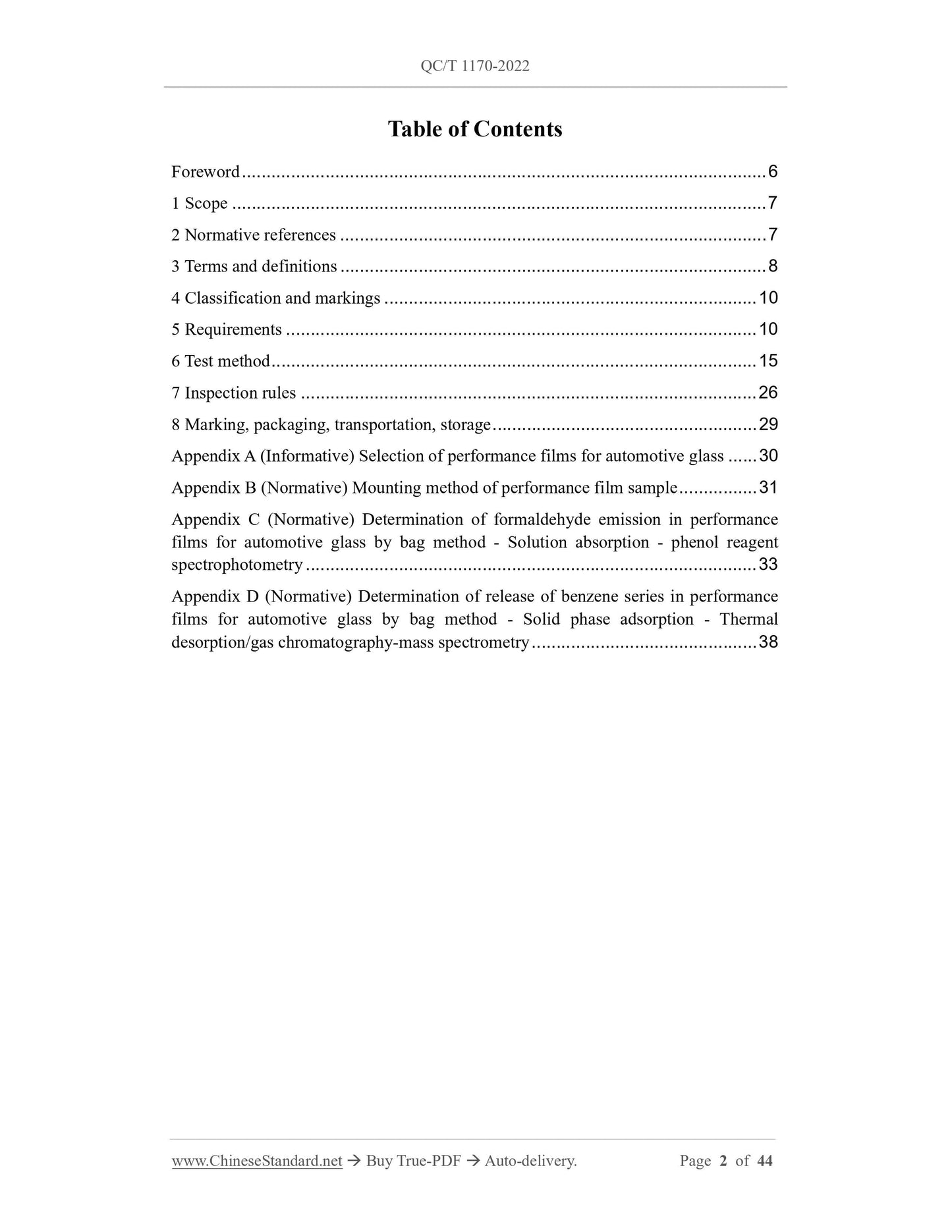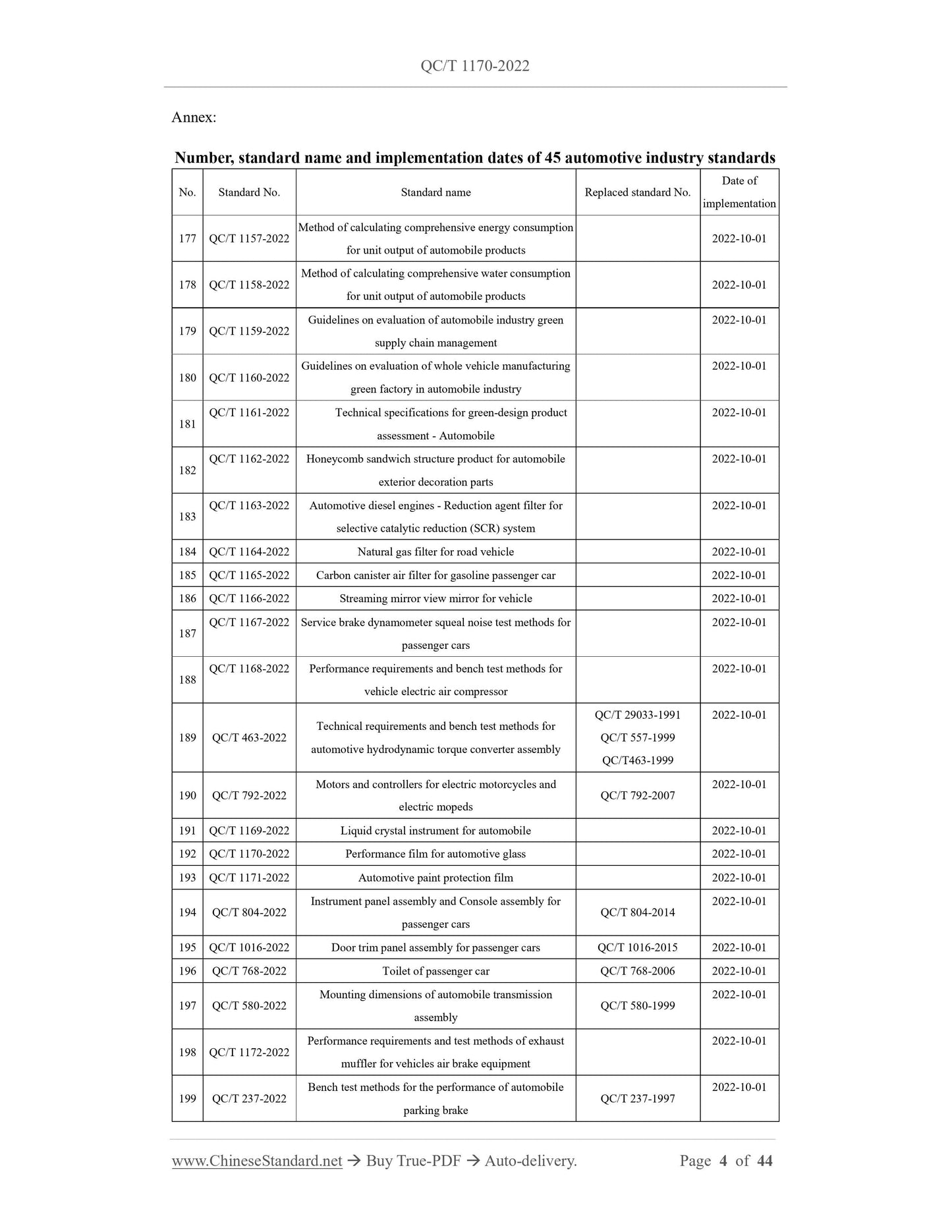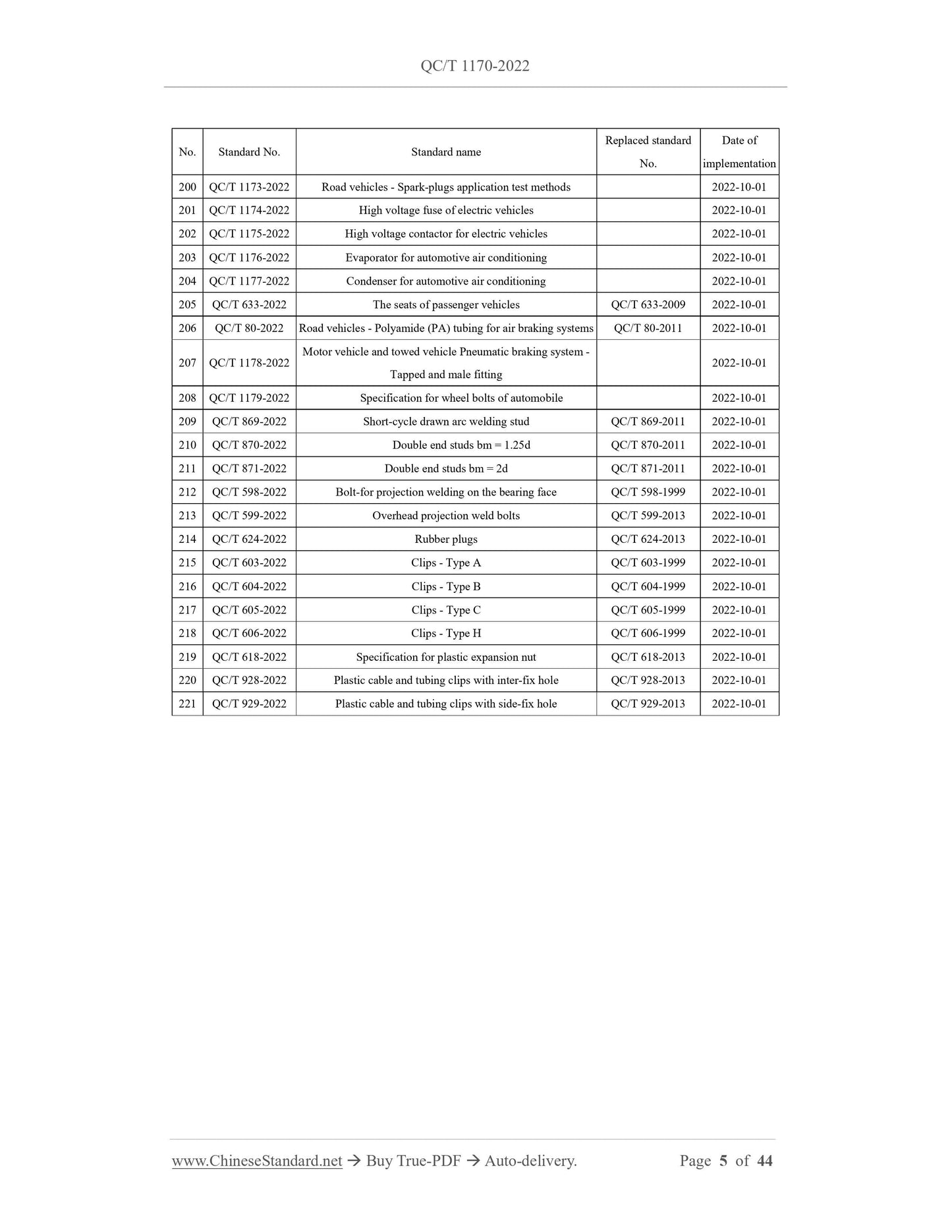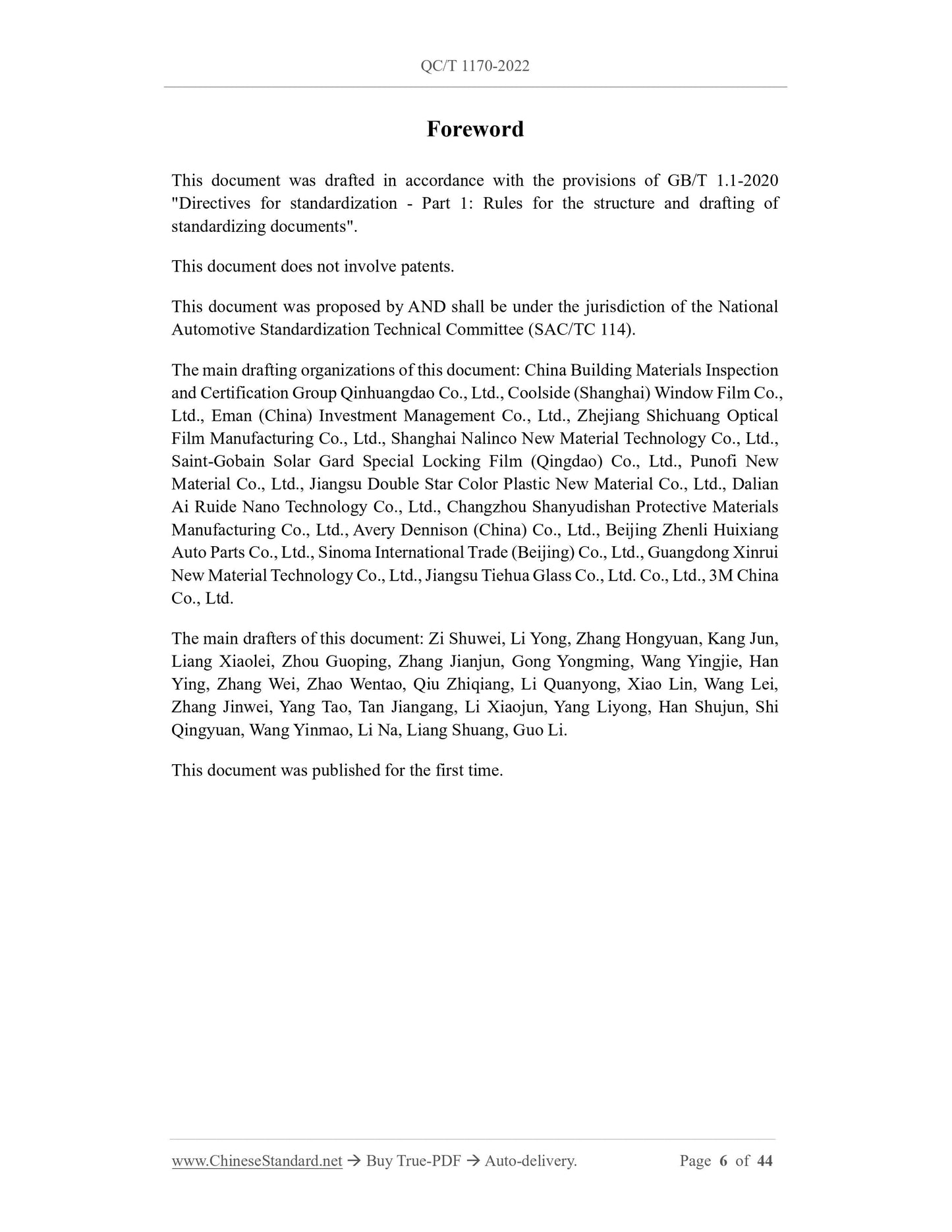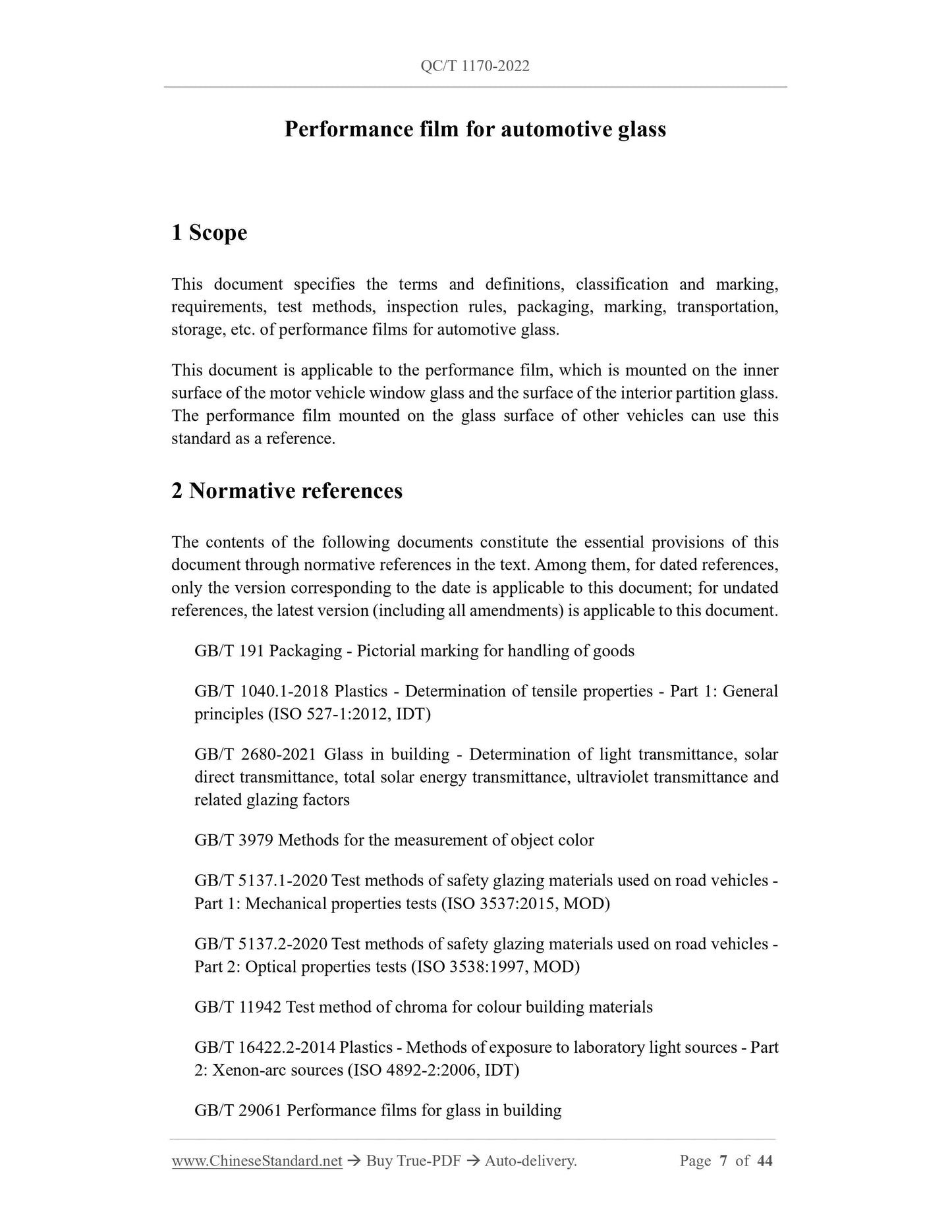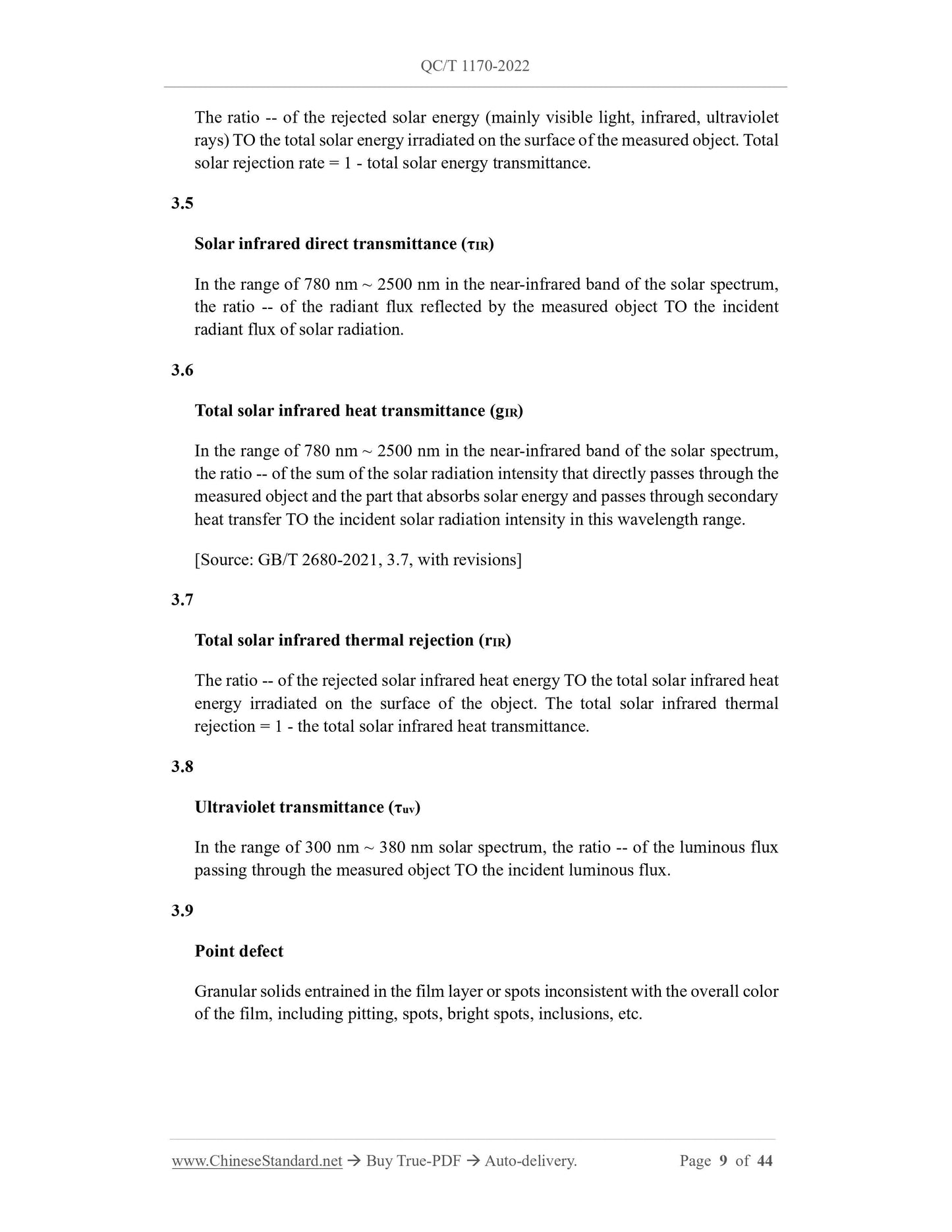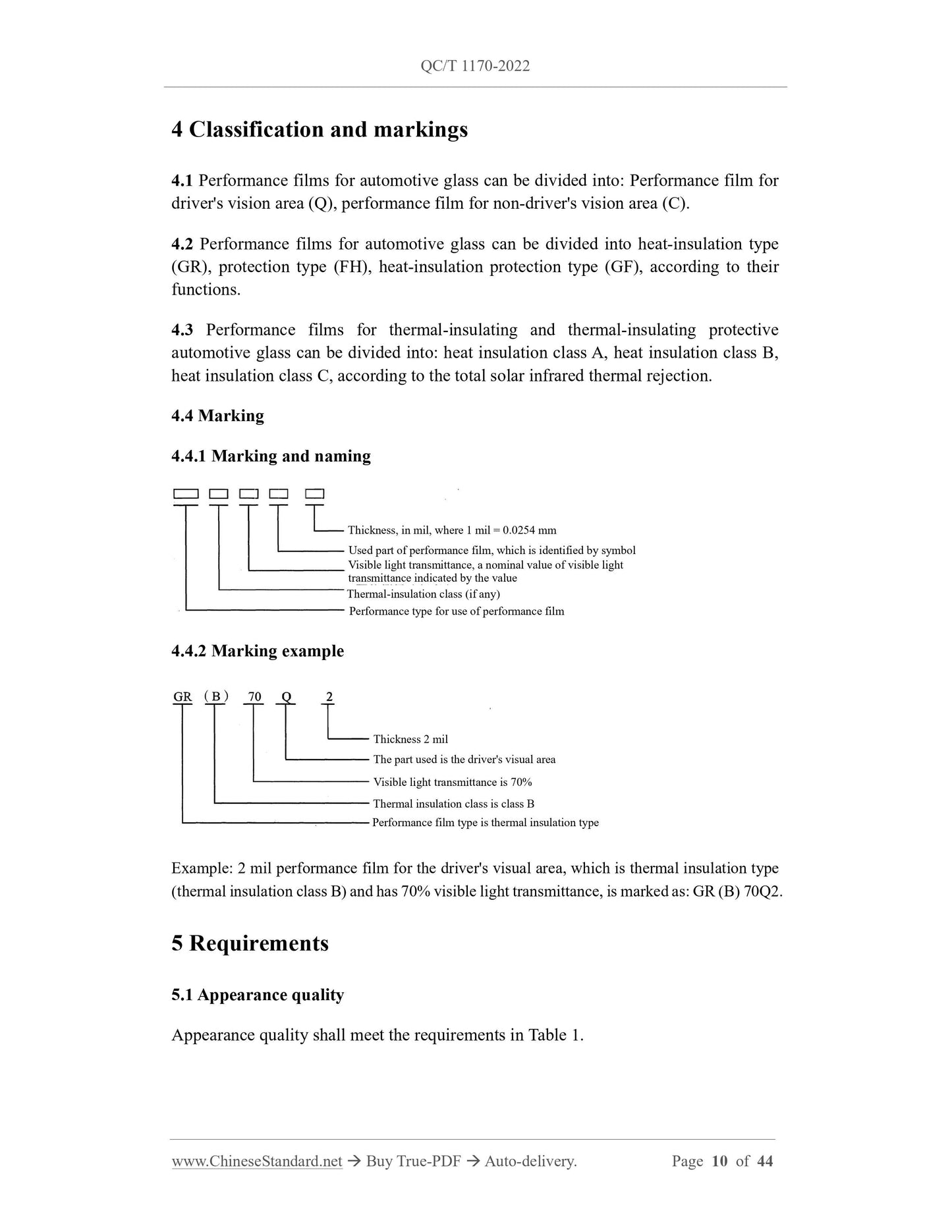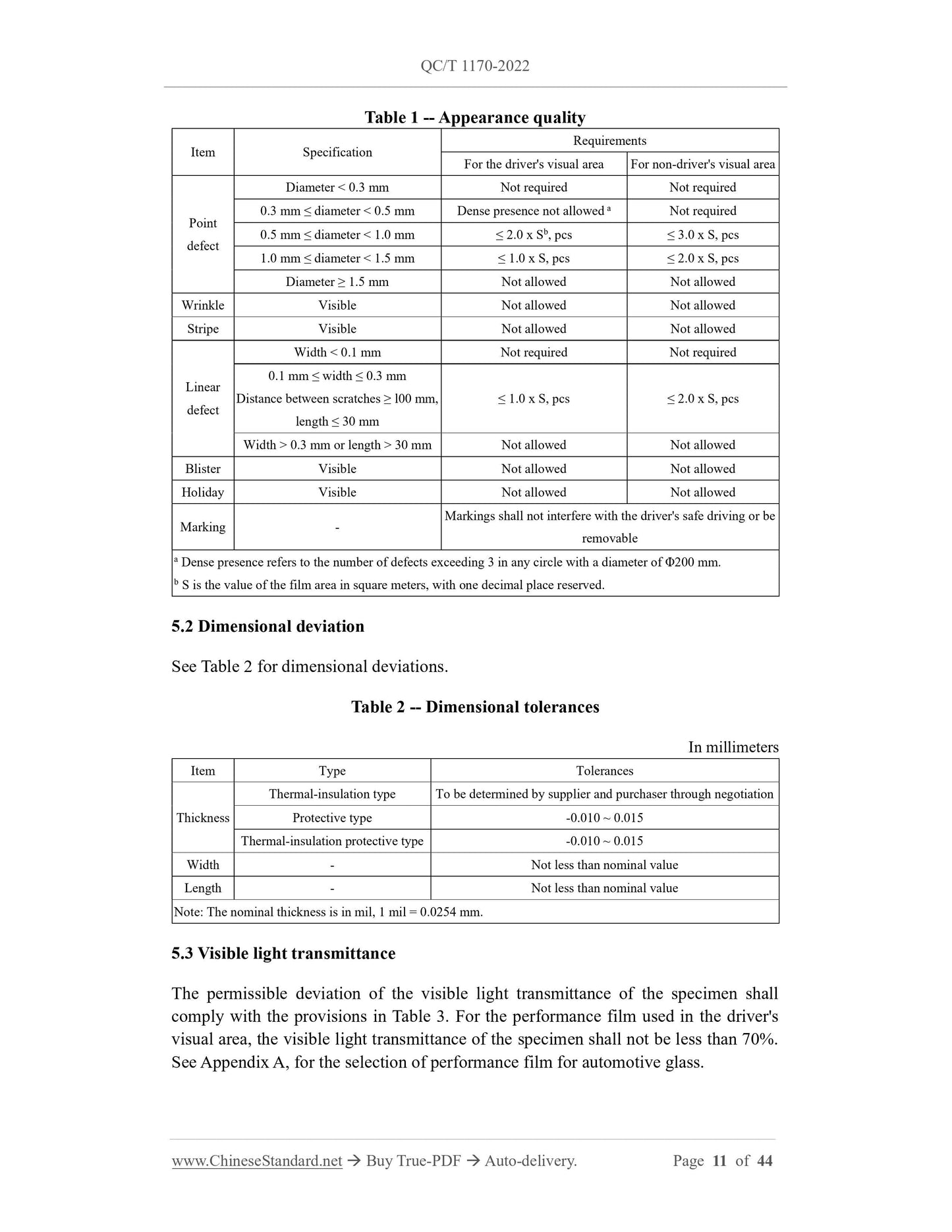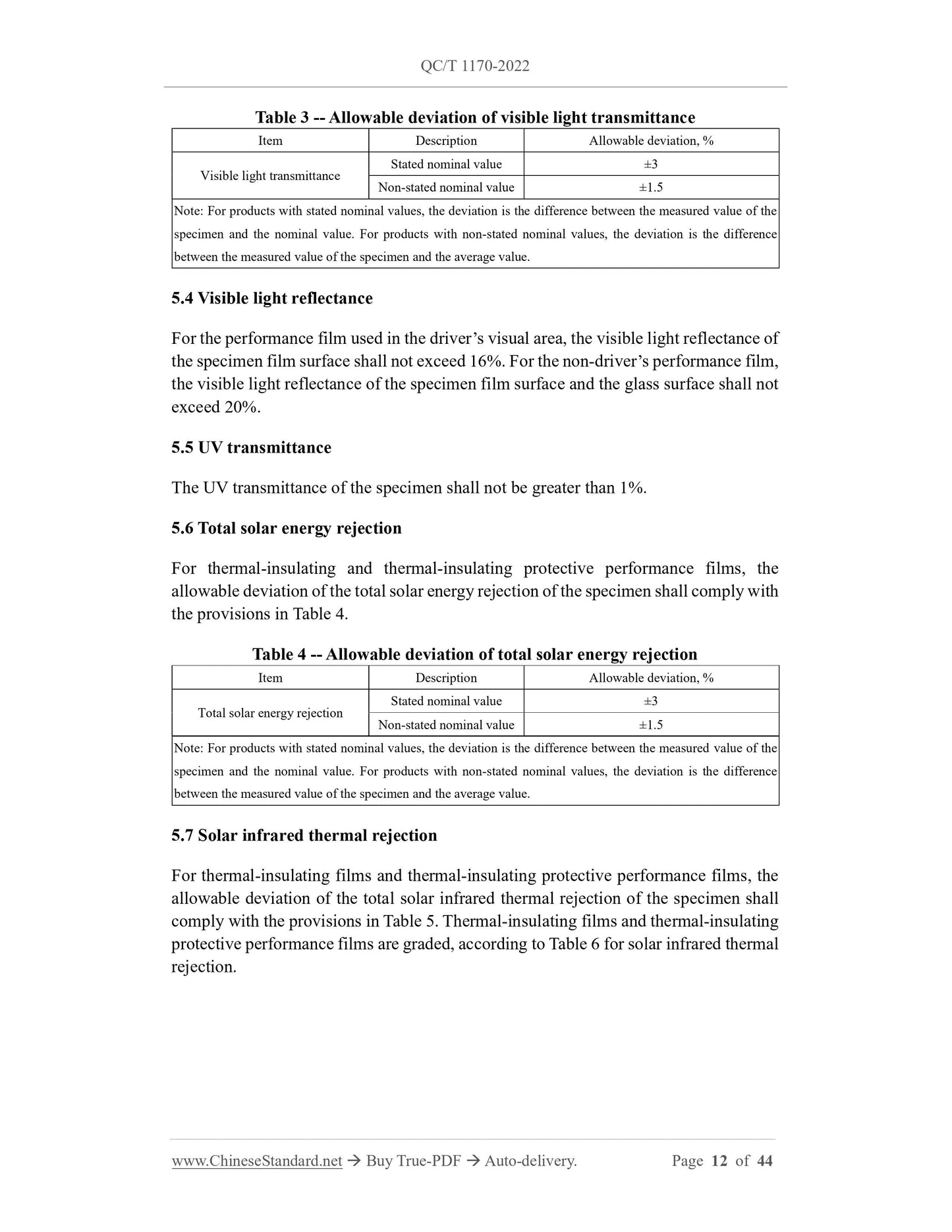1
/
/
12
PayPal, credit cards. Download editable-PDF & invoice in 1 second!
QC/T 1170-2022 English PDF (QCT1170-2022)
QC/T 1170-2022 English PDF (QCT1170-2022)
Normal fiyat
$500.00 USD
Normal fiyat
İndirimli fiyat
$500.00 USD
Birim fiyat
/
/
Kargo, ödeme sayfasında hesaplanır.
Teslim alım stok durumu yüklenemedi
Delivery: 3 seconds. Download true-PDF + Invoice.
Get QUOTATION in 1-minute: Click QC/T 1170-2022
Historical versions: QC/T 1170-2022
Preview True-PDF (Reload/Scroll if blank)
QC/T 1170-2022: Performance film for automotive glass
QC/T 1170-2022
QC
AUTOMOBILE INDUSTRY STANDARD
OF THE PEOPLE’S REPUBLIC OF CHINA
ICS 43.040.60
CCS T 26
Performance film for automotive glass
ISSUED ON: APRIL 08, 2022
IMPLEMENTED ON: OCTOBER 01, 2022
Issued by: Ministry of Industry and Information Technology of PRC
Table of Contents
Foreword ... 6
1 Scope ... 7
2 Normative references ... 7
3 Terms and definitions ... 8
4 Classification and markings ... 10
5 Requirements ... 10
6 Test method ... 15
7 Inspection rules ... 26
8 Marking, packaging, transportation, storage ... 29
Appendix A (Informative) Selection of performance films for automotive glass ... 30
Appendix B (Normative) Mounting method of performance film sample ... 31
Appendix C (Normative) Determination of formaldehyde emission in performance
films for automotive glass by bag method - Solution absorption - phenol reagent
spectrophotometry ... 33
Appendix D (Normative) Determination of release of benzene series in performance
films for automotive glass by bag method - Solid phase adsorption - Thermal
desorption/gas chromatography-mass spectrometry ... 38
Performance film for automotive glass
1 Scope
This document specifies the terms and definitions, classification and marking,
requirements, test methods, inspection rules, packaging, marking, transportation,
storage, etc. of performance films for automotive glass.
This document is applicable to the performance film, which is mounted on the inner
surface of the motor vehicle window glass and the surface of the interior partition glass.
The performance film mounted on the glass surface of other vehicles can use this
standard as a reference.
2 Normative references
The contents of the following documents constitute the essential provisions of this
document through normative references in the text. Among them, for dated references,
only the version corresponding to the date is applicable to this document; for undated
references, the latest version (including all amendments) is applicable to this document.
GB/T 191 Packaging - Pictorial marking for handling of goods
GB/T 1040.1-2018 Plastics - Determination of tensile properties - Part 1: General
principles (ISO 527-1:2012, IDT)
GB/T 2680-2021 Glass in building - Determination of light transmittance, solar
direct transmittance, total solar energy transmittance, ultraviolet transmittance and
related glazing factors
GB/T 3979 Methods for the measurement of object color
GB/T 5137.1-2020 Test methods of safety glazing materials used on road vehicles -
Part 1: Mechanical properties tests (ISO 3537:2015, MOD)
GB/T 5137.2-2020 Test methods of safety glazing materials used on road vehicles -
Part 2: Optical properties tests (ISO 3538:1997, MOD)
GB/T 11942 Test method of chroma for colour building materials
GB/T 16422.2-2014 Plastics - Methods of exposure to laboratory light sources - Part
2: Xenon-arc sources (ISO 4892-2:2006, IDT)
GB/T 29061 Performance films for glass in building
Using the specimen in 6.4, according to the method specified in 5.13 of GB/T 2680-
2021, measure the spectral transmittance and reflectance of the glass surface as well as
the emissivity of the film surface, at 780 nm ~ 2500 nm. Calculate the total solar
infrared thermal energy transmittance. Calculate the total solar infrared thermal
rejection, according to formula (2), expressed as a percentage. For products with stated
nominal values, calculate the difference between each measured value and the nominal
value; for products without stated nominal values, calculate the difference between each
measured value and the average value. When grading solar infrared rejection, take the
average value of 3 specimens.
Where:
rIR - Total solar infrared thermal rejection;
gIR - Total solar infrared energy transmittance.
6.9 Secondary image deviation
Attach 3 pieces of performance film to the inner surface of the windshield glass of the
automobile, that meets the requirement for the deviation of the secondary image
specified in GB 9656. The mounting method shall be in accordance with the provisions
of GB/T 31848. Place it under the environment as specified in 6.1 for 7 days. It shall be
tested, according to the method specified in Chapter 6 of GB/T 5137.2-2020.
6.10 Optical distortion
Attach 3 pieces of performance film to the inner surface of the windshield glass, that
meets the optical distortion requirements stipulated in GB 9656. The mounting method
shall be in accordance with the provisions of GB/T 31848. Place it under the
environment as specified in 6.1 for 7 days. It shall be tested, according to the method
specified in Chapter 7 of GB/T 5137.2-2020.
6.11 Color consistency
6.11.1 Specimen
Cut a specimen, which has a length of 1000 mm and a width equal to the package width,
at any position within a packaging unit. Take 5 samples of 50 mm x 50 mm, from the
four corners and the middle of the specimen. The outer edge of the specimen is 50 mm
from the edge of the film, as shown in the figure 4.
According to the spectrophotometric colorimetric method specified in GB/T 3979,
measure the spectral transmittance of the specimen, under the red, yellow, green light
sources that meet the chromaticity requirements specified in GB 14887. Use the CIE
1931 standard chromaticity system, to calculate the chromaticity coordinates.
Visually observe the colors of warning signs, prohibition signs, instruction signs, that
comply with the provisions of GB 5768.2-2009, through the specimen.
6.13 Haze
6.13.1 Specimen
Mount three pieces of 100 mm x 100 mm performance film, on the same size of 3 mm
flat glass, which has a visible light transmittance of 89% ± 1%, to make a specimen.
See Appendix B for the mounting method. Place the specimen under the conditions
specified in 6.1 for at least 24 h before the test.
6.13.2 Test device
The haze meter and abrasion meter shall comply with the provisions of GB/T 5137.1-
2020.
6.13.3 Measurement
The initial haze shall be measured according to the method specified in 7.5.3 of GB/T
5137.1-2020. Then the specimen shall be cleaned and ground 100 rotations, according
to the method specified in Chapter 7 of GB/T 5137.1-2020. Measure the haze after
abrasion. Calculate the difference between the haze after abrasion and the initial haze.
6.14 Maximum tensile force at break and elongation at break
6.14.1 Specimen
Take 3 performance films of 200 mmx (25 mm ± 0.5 mm), as shown in Figure 5. It shall
ensure that the edges of the specimen are neat and smooth without gaps. It shall be
placed, at least 24 hours, under the conditions specified in 6.1, before the test.
6.17 Aging resistance
6.17.1 Specimen
According to the method in 6.15.1, respectively attach three 250 mm x (25 ± 0.5) mm
performance films, to a 3 mm flat glass which is 125 mm x 50 mm AND has a visible
light transmittance of 89% ± 1%, to make specimen. It shall be placed under the
conditions specified in 6.1, for at least 7 days before the test.
6.17.2 Test device
The aging test chamber includes an irradiation system, a temperature control system,
and a blackboard temperature measuring device. The light source of the irradiation
system shall meet the requirements of GB/T 16422.2-2014, being equipped with the arc
lamp with daylight filter or equivalent light source. The irradiance of the specimen
surface is 1000 W/m2 ± 75 W/m2 in a wider passband (300 nm ~ 800 nm), or 110 W/m2
± 5 W/m2 in a wide passband (300 nm ~...
Get QUOTATION in 1-minute: Click QC/T 1170-2022
Historical versions: QC/T 1170-2022
Preview True-PDF (Reload/Scroll if blank)
QC/T 1170-2022: Performance film for automotive glass
QC/T 1170-2022
QC
AUTOMOBILE INDUSTRY STANDARD
OF THE PEOPLE’S REPUBLIC OF CHINA
ICS 43.040.60
CCS T 26
Performance film for automotive glass
ISSUED ON: APRIL 08, 2022
IMPLEMENTED ON: OCTOBER 01, 2022
Issued by: Ministry of Industry and Information Technology of PRC
Table of Contents
Foreword ... 6
1 Scope ... 7
2 Normative references ... 7
3 Terms and definitions ... 8
4 Classification and markings ... 10
5 Requirements ... 10
6 Test method ... 15
7 Inspection rules ... 26
8 Marking, packaging, transportation, storage ... 29
Appendix A (Informative) Selection of performance films for automotive glass ... 30
Appendix B (Normative) Mounting method of performance film sample ... 31
Appendix C (Normative) Determination of formaldehyde emission in performance
films for automotive glass by bag method - Solution absorption - phenol reagent
spectrophotometry ... 33
Appendix D (Normative) Determination of release of benzene series in performance
films for automotive glass by bag method - Solid phase adsorption - Thermal
desorption/gas chromatography-mass spectrometry ... 38
Performance film for automotive glass
1 Scope
This document specifies the terms and definitions, classification and marking,
requirements, test methods, inspection rules, packaging, marking, transportation,
storage, etc. of performance films for automotive glass.
This document is applicable to the performance film, which is mounted on the inner
surface of the motor vehicle window glass and the surface of the interior partition glass.
The performance film mounted on the glass surface of other vehicles can use this
standard as a reference.
2 Normative references
The contents of the following documents constitute the essential provisions of this
document through normative references in the text. Among them, for dated references,
only the version corresponding to the date is applicable to this document; for undated
references, the latest version (including all amendments) is applicable to this document.
GB/T 191 Packaging - Pictorial marking for handling of goods
GB/T 1040.1-2018 Plastics - Determination of tensile properties - Part 1: General
principles (ISO 527-1:2012, IDT)
GB/T 2680-2021 Glass in building - Determination of light transmittance, solar
direct transmittance, total solar energy transmittance, ultraviolet transmittance and
related glazing factors
GB/T 3979 Methods for the measurement of object color
GB/T 5137.1-2020 Test methods of safety glazing materials used on road vehicles -
Part 1: Mechanical properties tests (ISO 3537:2015, MOD)
GB/T 5137.2-2020 Test methods of safety glazing materials used on road vehicles -
Part 2: Optical properties tests (ISO 3538:1997, MOD)
GB/T 11942 Test method of chroma for colour building materials
GB/T 16422.2-2014 Plastics - Methods of exposure to laboratory light sources - Part
2: Xenon-arc sources (ISO 4892-2:2006, IDT)
GB/T 29061 Performance films for glass in building
Using the specimen in 6.4, according to the method specified in 5.13 of GB/T 2680-
2021, measure the spectral transmittance and reflectance of the glass surface as well as
the emissivity of the film surface, at 780 nm ~ 2500 nm. Calculate the total solar
infrared thermal energy transmittance. Calculate the total solar infrared thermal
rejection, according to formula (2), expressed as a percentage. For products with stated
nominal values, calculate the difference between each measured value and the nominal
value; for products without stated nominal values, calculate the difference between each
measured value and the average value. When grading solar infrared rejection, take the
average value of 3 specimens.
Where:
rIR - Total solar infrared thermal rejection;
gIR - Total solar infrared energy transmittance.
6.9 Secondary image deviation
Attach 3 pieces of performance film to the inner surface of the windshield glass of the
automobile, that meets the requirement for the deviation of the secondary image
specified in GB 9656. The mounting method shall be in accordance with the provisions
of GB/T 31848. Place it under the environment as specified in 6.1 for 7 days. It shall be
tested, according to the method specified in Chapter 6 of GB/T 5137.2-2020.
6.10 Optical distortion
Attach 3 pieces of performance film to the inner surface of the windshield glass, that
meets the optical distortion requirements stipulated in GB 9656. The mounting method
shall be in accordance with the provisions of GB/T 31848. Place it under the
environment as specified in 6.1 for 7 days. It shall be tested, according to the method
specified in Chapter 7 of GB/T 5137.2-2020.
6.11 Color consistency
6.11.1 Specimen
Cut a specimen, which has a length of 1000 mm and a width equal to the package width,
at any position within a packaging unit. Take 5 samples of 50 mm x 50 mm, from the
four corners and the middle of the specimen. The outer edge of the specimen is 50 mm
from the edge of the film, as shown in the figure 4.
According to the spectrophotometric colorimetric method specified in GB/T 3979,
measure the spectral transmittance of the specimen, under the red, yellow, green light
sources that meet the chromaticity requirements specified in GB 14887. Use the CIE
1931 standard chromaticity system, to calculate the chromaticity coordinates.
Visually observe the colors of warning signs, prohibition signs, instruction signs, that
comply with the provisions of GB 5768.2-2009, through the specimen.
6.13 Haze
6.13.1 Specimen
Mount three pieces of 100 mm x 100 mm performance film, on the same size of 3 mm
flat glass, which has a visible light transmittance of 89% ± 1%, to make a specimen.
See Appendix B for the mounting method. Place the specimen under the conditions
specified in 6.1 for at least 24 h before the test.
6.13.2 Test device
The haze meter and abrasion meter shall comply with the provisions of GB/T 5137.1-
2020.
6.13.3 Measurement
The initial haze shall be measured according to the method specified in 7.5.3 of GB/T
5137.1-2020. Then the specimen shall be cleaned and ground 100 rotations, according
to the method specified in Chapter 7 of GB/T 5137.1-2020. Measure the haze after
abrasion. Calculate the difference between the haze after abrasion and the initial haze.
6.14 Maximum tensile force at break and elongation at break
6.14.1 Specimen
Take 3 performance films of 200 mmx (25 mm ± 0.5 mm), as shown in Figure 5. It shall
ensure that the edges of the specimen are neat and smooth without gaps. It shall be
placed, at least 24 hours, under the conditions specified in 6.1, before the test.
6.17 Aging resistance
6.17.1 Specimen
According to the method in 6.15.1, respectively attach three 250 mm x (25 ± 0.5) mm
performance films, to a 3 mm flat glass which is 125 mm x 50 mm AND has a visible
light transmittance of 89% ± 1%, to make specimen. It shall be placed under the
conditions specified in 6.1, for at least 7 days before the test.
6.17.2 Test device
The aging test chamber includes an irradiation system, a temperature control system,
and a blackboard temperature measuring device. The light source of the irradiation
system shall meet the requirements of GB/T 16422.2-2014, being equipped with the arc
lamp with daylight filter or equivalent light source. The irradiance of the specimen
surface is 1000 W/m2 ± 75 W/m2 in a wider passband (300 nm ~ 800 nm), or 110 W/m2
± 5 W/m2 in a wide passband (300 nm ~...
Share
